Have you ever Googled your symptoms (and decided your headache was fatal) or looked for a provider online? With 63% of adults in the US using the internet to research health information, healthcare digital marketing has become essential for medical practices to reach and engage patients effectively. Digital marketing for healthcare providers offers a powerful way to connect with potential patients searching for medical services online.
It should be noted that healthcare digital marketing faces several challenges, including strict regulations around the use of patient data and limited resources for marketing budgets. However, the benefits of healthcare digital marketing outweigh the challenges. When done right, it can help healthcare organizations reach more patients and build stronger relationships with existing patients.
In this article, we will explore:
- The evolution of healthcare digital marketing
- Setting the foundation for healthcare digital marketing
- Crafting a healthcare digital marketing campaign

Short Summary
- The healthcare industry has seen a transition to digital marketing tactics due to changes in consumer behavior, cost, and the demand for personalized experiences.
- Establishing a solid foundation involves defining objectives, recognizing target demographics, analyzing competitors, and formulating a comprehensive Health Insurance Portability and Accountability Act HIPAA-compliant strategy.
- Healthcare providers can benefit from reputation management by monitoring reviews, addressing negative feedback, and showcasing positive testimonials to build trust with potential patients.
The Evolution of Healthcare Digital Marketing Strategy
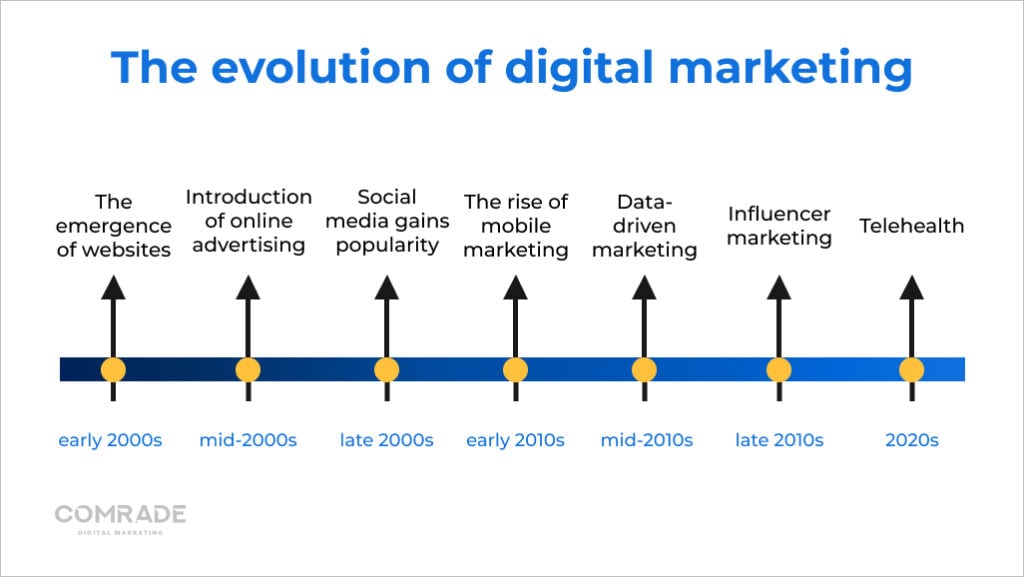
The healthcare industry has transformed from traditional advertising to comprehensive healthcare marketing services and digital strategies. This evolution of online healthcare marketing has reshaped how medical practices connect with patients. The timeline below outlines some of the key milestones and developments in the evolution of healthcare digital marketing:
The early 2000s: The emergence of websites
Healthcare organizations created websites to share information about their services, doctors, and facilities. Basic search engine optimization (SEO) techniques were employed to improve search rankings.
The mid-2000s: Introduction of online advertising
Healthcare organizations began experimenting with online advertising, such as banner ads and paid search ads. Google AdWords became a popular tool for this purpose.
The late 2000s: Social media platforms gain popularity
Healthcare organizations started exploring social media platforms like Facebook, Twitter, and YouTube to reach and engage with their audience. Content marketing and social media advertising became common practices.
The early 2010s: The rise of mobile marketing
The proliferation of smartphones and mobile apps led to expanding mobile marketing in healthcare. Organizations started optimizing their hospital websites for mobile devices and creating mobile apps for patient engagement and healthcare management.
The mid-2010s: Personalization and data-driven marketing
Healthcare digital marketing embraced data-driven strategies, utilizing patient data and analytics to personalize marketing messages and improve targeting. CRM systems and marketing automation platforms gained popularity.
The late 2010s: Influencer marketing and video content
Healthcare organizations tapped into influencer marketing, collaborating with trusted healthcare professionals or patient advocates to promote their services. Video content gained traction, with more healthcare organizations turning to healthcare video marketers for help producing educational videos and testimonials.
The 2020s: Telehealth and virtual care
The COVID-19 pandemic accelerated the adoption of telehealth and virtual care services for medical practices, making digital marketing essential. Healthcare organizations prioritized digital marketing efforts around promoting telehealth options and building trust in remote consultations.
Building Your Healthcare Digital Marketing Strategy: Essential Steps
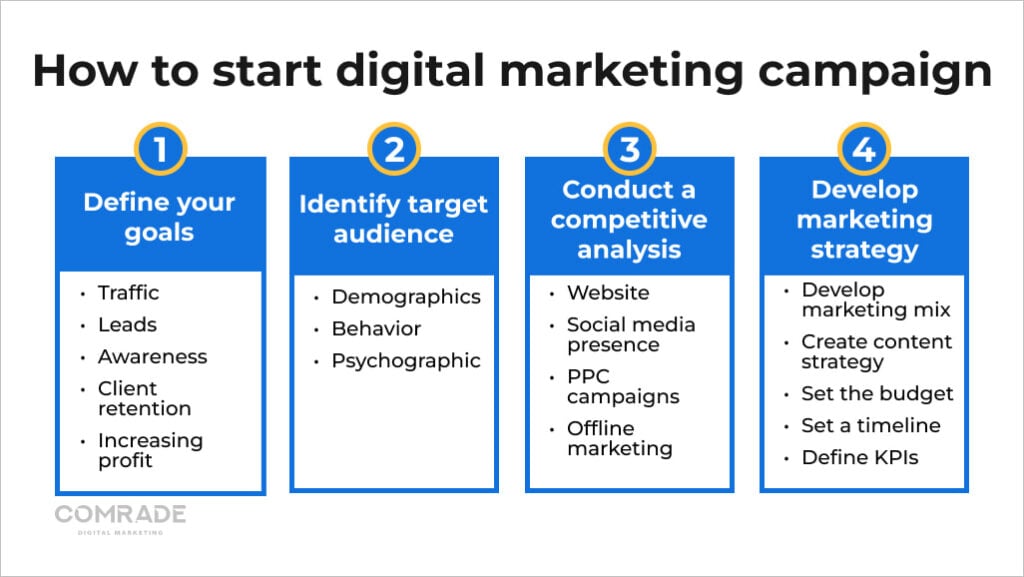
Medical marketing success requires healthcare providers to develop effective ways to find and connect with prospective patients. A strategic healthcare digital marketing approach ensures these tactics align with the growing demand for online health services.
1. Define Your Healthcare Marketing Goals
Before you can create a marketing budget, you need to identify your law firm’s business goals. These goals will shape your marketing strategy and determine the budget allocation for each marketing activity. It is important to ensure these goals are S.M.A.R.T — Specific, Measurable, Achievable, Relevant, and Time-bound.
- Specific goals are clearly defined and leave no room for ambiguity.
- Measurable goals can be quantified, making it easier to track progress.
- Achievable goals are realistic and can be accomplished with the available resources.
- Relevant goals are aligned with the overall business objectives.
- Time-bound goals have a specific deadline for completion.
Some S.M.A.R.T healthcare business goals include:
- Increasing website traffic and online presence
- Generating leads and acquiring new clients
- Building brand awareness and reputation
- Improving client retention and loyalty
- Increasing revenue and profits
2. Identify Your Target Audience
A key step of any healthcare digital marketing project is defining the target demographic. This is the group of people who are most likely to be interested in your products or services and most likely to be influenced by your marketing messages. Here are some of the factors to consider when identifying your healthcare target audience:
- Demographics: Age, gender, income, education, etc.
- Psychographics: Interests, hobbies, values, etc.
- Behavioral data: What websites do they visit? What social media platforms do they use? What products or services do they buy?
CRM platforms enable marketers to construct specific personas around which campaigns can be focused for maximum effect. This level of audience segmentation helps tailor every aspect, from promotional materials to content delivery. Here are the steps for creating these client personas:
- Start by brainstorming a list of potential healthcare consumers.
- Then, gather data about your target audience. This can include information from your website analytics, social media, and customer surveys.
- Once you have a good amount of data, create a profile for your ideal customer. Include information about their demographics, psychographics, and behavioral data.
- Finally, review your client persona and make any necessary changes.
3. Conduct a Competitive Analysis
Competitive analysis helps identify the strengths and weaknesses of competitors in the industry, as well as the opportunities and threats in the market. Tools such as Google Analytics, SEMrush, and Ahrefs help identify the keywords competitors are ranked for, their website traffic, and the types of content driving engagement.
Additionally, healthcare organizations can analyze the social media presence of their competitors, including the number of followers, engagement rates, and content strategy.
Key things to consider when conducting a competitive analysis:
- Their website: What is their website like? Is it easy to navigate? Is the content relevant and informative?
- Their social media presence: What are their social media accounts like? Are they active? Do they post engaging content?
- Their paid advertising campaigns: What types of paid advertising campaigns are they running? Are they successful?
- Their offline marketing efforts: What types of offline marketing efforts are they doing? Are they effective?
4. Develop Your Healthcare Marketing Strategy
A comprehensive healthcare marketing strategy outlines the tactics and resources required to meet the goals set.
- Develop a marketing mix. This includes digital marketing platforms to reach your target audience, such as your website, social media, and paid advertising.
- Create a content strategy that is aligned with the goals and target audience. The content should be educational, informative, and engaging. It can include blog posts, infographics, videos, and webinars.
- Determine the budget for your marketing campaign, including the cost of creating content, advertising, and hiring staff or consultants.
- Set a timeline for the campaign, including the launch date, content creation schedule, and advertising schedule.
- Define key performance indicators (KPIs) to measure the marketing campaign’s success. This can include website traffic, lead generation, social media engagement, and sales.
Craft a Healthcare Digital Marketing Campaign
Healthcare providers can reach a larger audience and make the most of their marketing plans by combining various digital marketing approaches, like SEO, social media advertising, email campaigns, reputation management, and campaign analysis, to form an effective overall campaign. Let’s take a closer look at each of these!
Search Engine Optimization (SEO) for Healthcare Providers
Search engines drive three times more visitors to hospital websites than other sources, and over 60% of customers research hospitals, nurses, doctors, etc. before making an appointment. This alone is proof that SEO is a vital part of healthcare digital marketing.
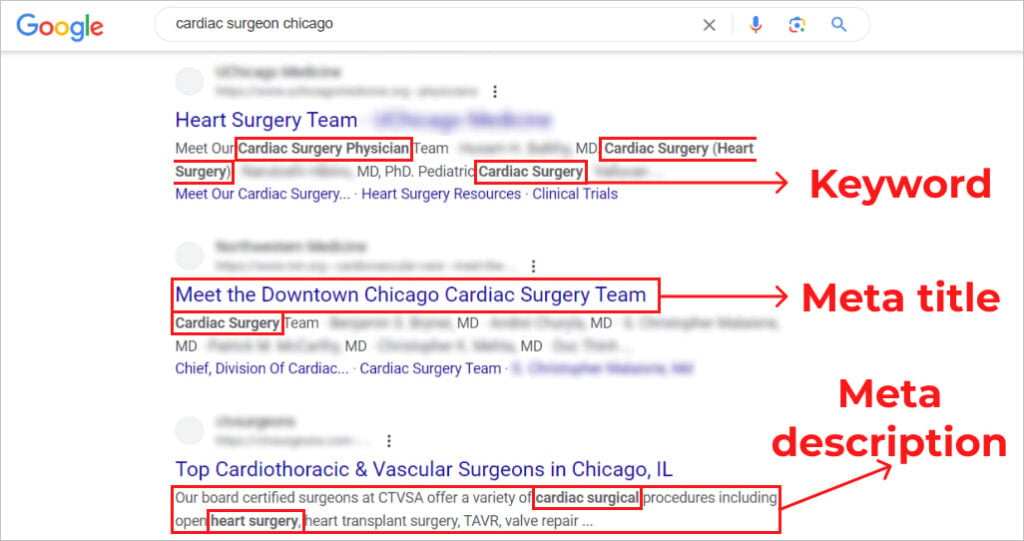
There are various SEO strategies and techniques that can be implemented to optimize your website for visibility and organic traffic, leading to increased patient acquisition.
1. Keyword Research
Keyword research identifies the keywords and phrases people use to search for information online. Once you know what keywords your target audience uses, you can use them in your website content, titles, and meta descriptions to improve your chances of ranking higher in the SERPs.
There are a number of digital tools available to help you with keyword research, such as Google Keyword Planner, SEMrush, and Ahrefs. These tools can help you to identify the most popular keywords for your industry and the search volume and competition for each keyword.
2. Content Creation
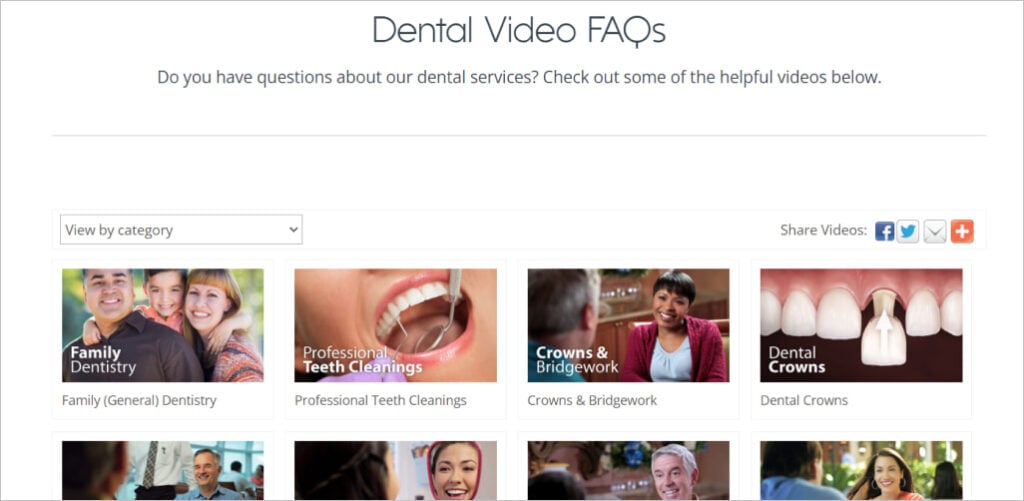
Content is king regardless of the industry. The more relevant and high-quality content you create, the more likely you’ll rank well in the SERPs. Here are some specific types of content that you can create for healthcare marketing:
- Blog posts: These are a great way to share your expertise and provide valuable information to your target audience.
- White papers: These are long-form articles that provide in-depth information on a particular topic.
- Case studies: These are a great way to show how your services have helped other patients (while maintaining HIPAA compliance).
- Infographics: These are a great way to communicate information visually.
- Videos: Videos are a great way to engage your audience and share your message.
To optimize the content for SERPs, healthcare providers can follow these tips:
- Use the targeted keywords in the title, meta description, and throughout the content, but avoid keyword stuffing.
- Write high-quality, engaging content that provides value to the user.
- Use subheadings and bullet points to make the content easy to read.
- Include internal and external links to relevant sources.
- Use multimedia such as images, videos, and infographics to make the content more engaging.
- Ensure the website is mobile-friendly and has a fast loading speed.
Losing leads to your competitors? A senior living marketing agency can help you win them back.
3. Technical SEO
Technical SEO refers to optimizing a healthcare provider’s website’s technical elements to ensure search engines can crawl and index it effectively.
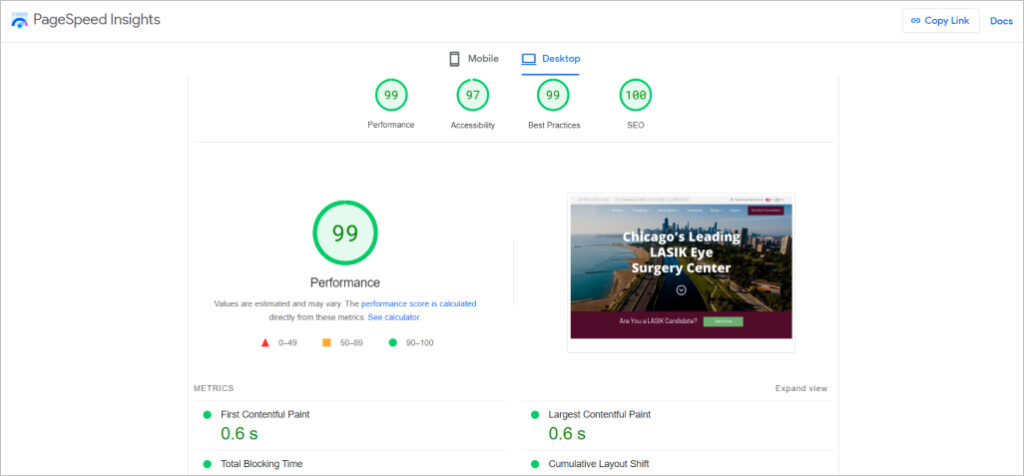
There are several key elements of technical SEO that healthcare providers should focus on:
- Website speed: The loading speed of a website affects user experience and search engine rankings. Optimize images, leverage browser caching, and reduce server response time to improve website speed.
- Mobile-friendliness: With the increasing use of mobile devices, you must have a responsive website design. It ensures the website displays and functions well on different screen sizes, leading to better user engagement and SEO performance.
- XML sitemap: Create and submit an XML sitemap to search engines to help them understand the structure and content of the website, leading to better indexing and ranking.
- URL structure: Simplify and optimize URL structure to improve search engine crawling and indexing. Use descriptive keywords and avoid excessive parameters in URLs.
- Internal linking: Proper internal linking helps search engines understand the website’s hierarchy and relationship between pages. It also distributes link equity and improves navigation.
- Structured data markup: Implementing structured data markup, such as schema.org, provides search engines with additional information about the website’s content, making it more visible in SERPs through rich snippets.
- HTTPS security: Using secure connections (HTTPS) helps protect user data and improve trust. It also provides a slight ranking boost, according to Google.
Stop losing patients to competitors! Boost your visibility with expert ophthalmology SEO—drive more traffic and grow your practice today.
4. Link Building
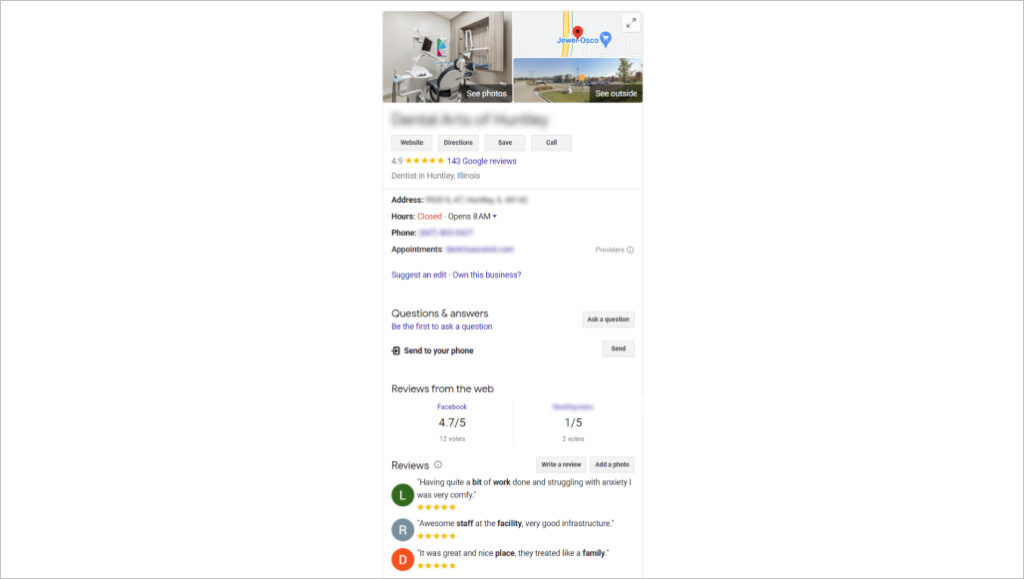
Link building is an integral part of SEO that focuses on acquiring high-quality external links from other websites. These links act as endorsements or votes of confidence, signaling to search engines that the website is trusted and authoritative. Try some of these link building options:
- Guest blogging: Write articles for authoritative healthcare websites to showcase your expertise and gain valuable backlinks.
- Partnerships and collaborations: Build relationships with organizations, industry influencers, and medical professionals to get opportunities for link sharing or collaborations on content creation.
- Outreach and PR: Reach out to relevant websites or publications and pitch unique healthcare-related stories, news, or research studies that can result in backlinks and media coverage.
- Local citations: For healthcare providers with physical locations, securing listings in online directories, such as Google My Business, Yelp, or Healthgrades, can improve local SEO and generate backlinks.
Social Media Marketing for Healthcare
Many healthcare providers use one or more social media platforms to connect with clients, existing and potential. Popular social media platforms such as Facebook, Twitter, or LinkedIn, for example, enable healthcare practitioners to develop and post valuable content and interact with their followers while promoting their medical services across broader audiences.
An active presence on social networks provides some benefits that enhance their online presence.
1. Building Brand Awareness
Healthcare providers can demonstrate their brand identity, mission, and expertise through social media platforms. They can develop their authority and position in the healthcare sector by continuously delivering relevant and useful material.
Providers can develop credibility and trust with their audience by publishing instructional articles, infographics, videos, and success stories. Additionally, timely user interaction and responses to comments and questions help promote a positive brand image.
2. Patient Engagement
With healthcare social media marketing, healthcare professionals can interact with current and prospective patients. Patients can stay updated on forthcoming events, news, and updates relevant to the healthcare practice by actively engaging with patients on their social media sites.
Social media also allows users to share their experiences, ask questions, and give feedback, fostering open dialogue and strengthening the bonds between patients and healthcare professionals.
3. Targeted Advertising

Healthcare providers can use social media platforms for targeted advertising to those interested in their services. This can be done using advanced options on Facebook and LinkedIn, allowing them to create campaigns tailored to their desired demographic. Some of the most common types of social media ads include:
- Sponsored posts: These appear in a user’s newsfeed and are marked as “sponsored.” They can include text, images, and videos and target specific audiences.
- Display ads: These appear on the side or top of a user’s newsfeed. They can include images and text and can be targeted to specific audiences.
- Video ads: These are ads that appear in a user’s newsfeed and are played automatically. They can include text, images, and videos and can be targeted to specific audiences.
- Carousel ads: These are ads that include multiple images or videos that users can swipe through. They can be targeted to specific audiences based on interests and behaviors.
Using Facebook, Twitter, LinkedIn, and Instagram for Marketing
- Facebook: Healthcare providers can create a Facebook page to share relevant content, connect with the community, and provide updates on services and events. They can join healthcare-related groups, engage with users through comments, and use Facebook Live to host Q&A sessions or educational talks.
- Twitter: Healthcare providers can utilize Twitter to share timely news, articles, and health tips to engage their audience. They can participate in healthcare chats and use hashtags related to their specialty to increase visibility.
- LinkedIn: Healthcare providers can use LinkedIn to build professional connections, share industry-related articles, and participate in healthcare-related groups. LinkedIn Pulse allows providers to publish thought leadership articles, further establishing their expertise.
- Instagram: Providers can use Instagram to humanize their brand by sharing behind-the-scenes content, patient success stories, and wellness tips. They can use relevant hashtags and collaborate with influencers to expand their reach.
Digital marketing can be easier with the Comrade Digital Marketing Agency. Schedule a free consultation.
Email Marketing in Healthcare
Email marketing enables healthcare organizations to reach and engage with their target audience effectively. With the ability to deliver tailored messages directly to individuals’ inboxes, email marketing allows healthcare providers to promote new services, educate patients about their conditions or available services, remind clients about appointments, and build strong relationships with their patients.
In this part of the article, we will delve into three key aspects of email marketing in healthcare: segmentation, personalization, and automation.
1. Segmentation
Segmentation in digital healthcare marketing enables providers to divide people into different groups based on their characteristics, attributes, or behaviors. This way, marketers can create messages more suitable for the specific target audience and increase their email campaigns’ open and click-through rates.
For example, the pediatrics department of a hospital may segment their email list into expecting parents, parents of infants, and parents of toddlers. This segmentation allows them to customize their emails’ content to address each segment’s specific concerns, interests, or needs. Expecting parents or guardians may receive content about prenatal care, while parents of toddlers may receive information on child development milestones.
Through segmentation, healthcare providers can ensure that their email campaigns are more effective and resonate with patients more individually.
2. Personalization
Personalization of email campaigns can offer healthcare providers an advantage in enhancing user experience and customer satisfaction. It adds unique details to your emails to make them feel more personal. This can be done by using the recipient’s name, referring to their past interactions with your organization, or using images or other content relevant to their interests.
For instance, an email reminder for an annual check-up can include the patient’s previous test results and recommendations for follow-up procedures based on their medical history.
3. Automation
Specific events or actions, such as a new patient registration, appointment booking, or post-visit feedback request, can trigger automated email campaigns. Automation ensures consistent, personalized messaging without excessive manual effort. For example, an automated welcome email can be sent upon new patient registration, providing essential information about the healthcare facility, services offered, and potential next steps.
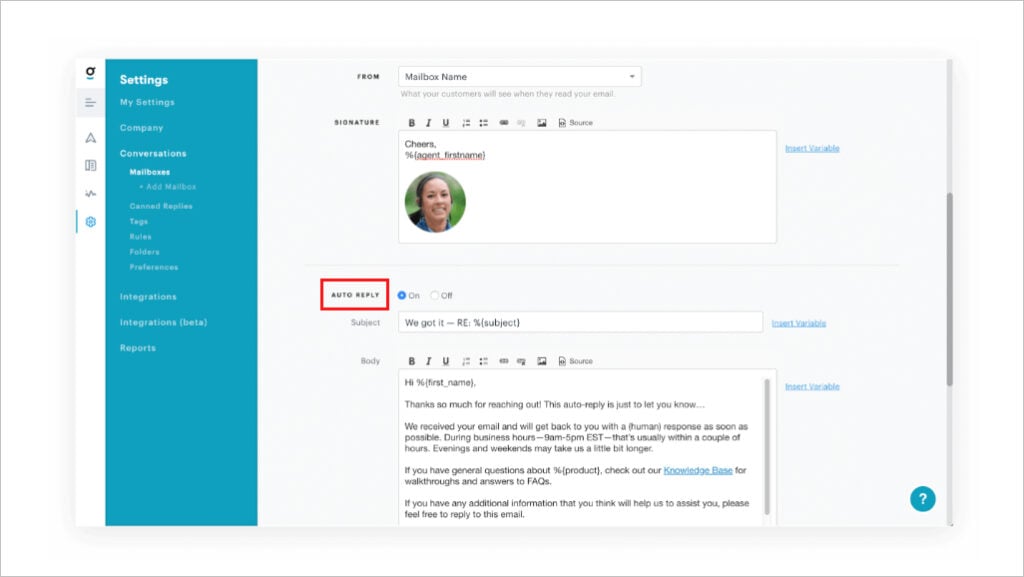
Automation also plays a vital role in patient engagement and education. For instance, healthcare organizations can set up automated email series to educate patients pre and post-surgery, providing them with necessary instructions and guidance throughout their healthcare journey. Healthcare providers can save time, improve efficiency, and deliver a more customized, consistent patient experience through automation.
Reputation Management for Healthcare Providers
Patients heavily rely on online reviews and ratings to make informed decisions regarding their healthcare choices. A good reputation can attract new patients and boost referrals, while a bad reputation can lead to lost business and even lawsuits. Therefore, healthcare providers must actively manage their online reputation using the points below to ensure a positive patient perception.
1. Monitor Reviews

Healthcare providers should regularly monitor their online presence to keep track of patient reviews and ratings on platforms such as Google My Business, Yelp, and Healthgrades, as well as reviews on social media platforms like Facebook. This allows them to pinpoint any potential issues with the healthcare services being provided so they may take action promptly and ensure high patient satisfaction.
2. Address Negative Feedback
Negative feedback can be detrimental to a healthcare provider’s reputation, so it’s really important to address negative feedback promptly and professionally. Apologize for any inconvenience the patient experienced, and explain what you’re doing to fix the problem. Address these complaints through open channels to create trust among potential patients, illustrating the organization’s transparency and customer service focus.
It’s also important to respect the patient’s opinion, even if you disagree. Don’t try to argue with the patient or make excuses. Just listen to what they say, and thank them for their feedback.
3. Showcase Positive Testimonials
Share positive client testimonials on various platforms, such as the provider’s website or social media pages, to influence potential clients’ decision-making process. Feature success stories from your current clients so interested individuals can witness firsthand how reliable you are in providing effective care. Don’t forget to share these endorsements online or within advertisements. This tactic will increase reach and strengthen digital presence for patient acquisition and retention.
Analytics and Data-Driven Decision Making in Healthcare Digital Marketing
For healthcare digital marketing to be successful, leveraging the power of analytics and data-driven decision-making is essential. Healthcare providers can track indicators such as website traffic, conversion rates, and social media engagement to evaluate their promotional campaigns’ effectiveness and refine them accordingly.
1. Key Performance Indicators (KPIs)
KPIs are metrics used to evaluate the performance of a marketing campaign or strategy. They provide a quantifiable measure of progress toward specific goals of healthcare digital marketing. Some key KPIs to analyze include website traffic, conversion rate, engagement metrics, email open rates, customer acquisition cost, healthcare marketing ROI, and customer lifetime value (CLV).
For example, tracking website traffic and conversion rate can help determine the effectiveness of marketing channels, while customer acquisition cost helps understand the cost-performance ratio of marketing campaigns.
2. Google Analytics
Google Analytics is a robust analytics platform that provides valuable insights into website traffic, user behavior, and campaign performance. Healthcare providers can track key data points using Google Analytics, such as the number of visitors, sources of traffic, bounce rate, average session duration, and conversion goals.
Furthermore, Google Analytics offers advanced features like demographic analysis and tracking specific events or actions taken on the website. These insights help healthcare providers refine their digital marketing strategies, allocate resources, and target the right audience to maximize their impact and achieve their marketing objectives.
Future Trends in Healthcare Digital Marketing
In this day and age of rapidly advancing technology, digital marketing in healthcare is sure to have a bright future. Many new applications, such as AI, virtual reality, and telehealth, could completely transform patient care and how health practitioners market their services. Healthcare marketers need to stay updated on the latest digital marketing trends if they want their strategies to remain relevant for connecting with those interested in what these providers offer. By keeping up with advancements in digital healthcare, businesses can successfully target a suitable audience while still providing top-notch medical attention.
Artificial Intelligence
Artificial intelligence (AI) has the potential to revolutionize healthcare digital marketing by providing personalized recommendations and improving the patient experience. AI can analyze large amounts of patient data to identify patterns and make recommendations tailored to individual patient needs. This can help healthcare providers deliver more targeted marketing messages and improve patient engagement. AI can also be used to automate routine tasks, such as appointment scheduling and prescription refills, freeing up staff time and resources.
Virtual Reality
Virtual reality (VR) is a technology that allows patients to experience healthcare services more immersive and engagingly. VR can create virtual tours of healthcare facilities, educate patients about medical procedures, and provide mental and physical health therapy. VR can also simulate medical emergencies, allowing healthcare providers to train staff in a safe and controlled environment.
Telehealth
Telehealth has become popular recently, especially in light of the COVID-19 pandemic. Telehealth allows patients to receive medical care remotely without visiting a healthcare facility. It can be used to promote virtual consultations, provide online resources and education, and offer remote monitoring services.
In addition to telehealth, there is also a growing trend of health and fitness apps that can help patients manage their health and wellness. These apps can help patients track their fitness goals, monitor their calorie intake, and even provide personalized workout plans. Healthcare providers can leverage these apps to improve patient engagement and promote healthy lifestyle habits.

See how digital marketing solutions can help you stay ahead of the competition
Conclusion
As healthcare digital marketing continues to evolve, medical practices must leverage digital marketing for healthcare effectively to stay competitive. The future of online healthcare marketing offers enormous potential for practices that embrace comprehensive digital strategies. The key lies in unlocking this potential through strategic and data-driven digital marketing. Digital tactics have adapted over time and this blog post has outlined what practitioners need to do for success.
For healthcare providers seeking to embrace digital transformation, working with an experienced full-service digital marketing agency like Comrade Digital Marketing Agency is best. Our team of experts has a deep understanding of the healthcare industry, and offers a range of full-service solutions that can be tailored to meet each client’s unique needs. These services include website design and development, search engine optimization, and paid advertising. With our help, you can improve your online presence, attract new clients, retain existing ones, and grow your revenue.
